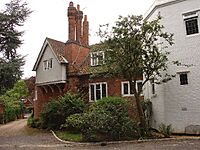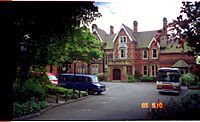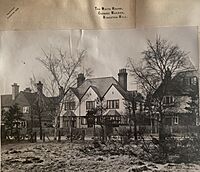Coombe, Kingston upon Thames facts for kids
Quick facts for kids Coombe |
|
|---|---|
 Coombe Warren Lodge, Coombe Lane |
|
| Population | 20,108 (2011 Census. Coombe Hill and Vale Wards) |
| OS grid reference | TQ208703 |
| London borough | |
| Ceremonial county | Greater London |
| Region | |
| Country | England |
| Sovereign state | United Kingdom |
| Post town | KINGSTON UPON THAMES NEW MALDEN |
| Postcode district | KT2, KT3 |
| Dialling code | 020 |
| Police | Metropolitan |
| Fire | London |
| Ambulance | London |
| EU Parliament | London |
| London Assembly |
|
Coombe is a historic and fancy neighborhood in south west London, England. It's located in the Royal Borough of Kingston upon Thames, on high ground east of Norbiton. Most of Coombe was once part of a different local area before 1965. Today, it shares borders with the London boroughs of Merton and Sutton. To the north, you'll find Kingston Hill and Kingston Vale, and beyond that, the beautiful Richmond Park.
Contents
History of Coombe
Coombe's story began around a large house called Coombe House, built in the 1750s. This house is gone now, but you can still see its old red brick walls on Traps Lane.
Ancient Times and the Domesday Book
This area has a very long history! People have found Roman coins and other old items near Warren Road. Coombe was even mentioned in the Domesday Book of 1086, which was a huge survey ordered by William the Conqueror. Back then, it was called Cumbe. It had some farmland, meadows, and even pigs!
The Neville Family and Old Stories
The Neville family has been connected to Coombe for a long time. In 1215, King John gave Coombe to Hugh de Neville, and by 1260, it was known as Coombe Nevill. Today, there's a street called Coombe Neville in the same spot, and Neville Avenue is nearby.
In the 1500s, there was a gallows in Coombe, which was a place where public executions happened.
Pubs and Famous Owners
In the early 1700s, a pub called the Fox and Coney opened. It was rebuilt in 1728 and later became the George and Dragon. This pub stayed open until 1985, when it changed into the Kingston Lodge Hotel.
By 1761, a very important person, John Spencer, 1st Earl Spencer, owned Coombe.
Coombe Warren and Highwaymen
Coombe Warren was a wild, wooded area on a ridge called Coombe Hill. People used to go there for hunting and public fairs. A famous highwayman (a robber who attacked travelers on roads) named Jerry Abershaw used to hide in these woods in the late 1700s.
In 1822, the Admiralty built a semaphore station in Coombe Warren. This station was part of a communication system that sent messages from London to Portsmouth using signals. The station is gone now, but a house called "Telegraph Cottage" kept its name alive.
Growth and World War II
By 1911, Coombe had two golf courses and many large houses. Some of these houses are now schools, like Rokeby School for Boys (formerly Coombe Croft) and Holy Cross Preparatory School (formerly Coombe Ridge).
During World War II, many German bombs fell on Coombe.
Coombe Today
Today, Coombe is known as a very fancy place to live, and houses here are quite expensive. A big part of the area is taken up by two golf courses: Coombe Wood and Coombe Hill. There are also three private estates with private roads, though most people can access them. These estates are called Coombe Hill, Coombe Warren, and Coombe Park.
Notable Buildings in Coombe
Coombe has some really old and important buildings. Some of them are "Grade II-listed," which means they are protected because of their special history or architecture.
- Tudor-era Water Conduits: Three structures from the Tudor period (when Henry VIII was king) were built to supply water to Hampton Court Palace from springs in Coombe. These are Coombe Conduit, Ivy Conduit, and Gallows Conduit.
- Warren House: This beautiful house on Warren Road was built in the 1860s for a banker named Hugh Hammersley. It was made even bigger later by a famous architect, George Devey.
- Cedar Court: Built in 1911–12, this house on Coombe Hill Road is special because it uses old wooden beams from a medieval building that was taken apart in Colchester.
Famous People Connected to Coombe
Many interesting people have lived in or visited Coombe:
- Joss Ackland: A well-known actor.
- Edward Charles Baring: He asked architect George Devey to design several buildings in Coombe.
- John G. Bennett: A scientist and spiritual leader who lived and taught at Coombe Springs.
- Kenelm Lee Guinness: From the famous Guinness brewing family, he was also a racing driver and held the world land speed record! He invented KLG sparking plugs.
- Malcolm Campbell: Another famous racing driver who held the world land speed record.
- Donald Campbell: Malcolm's son, who held the world water speed record. He lived in the same house as his father.
- Annabel Croft: A former professional tennis player.
- Dwight D. Eisenhower: During World War II, when he was the top Allied commander, he lived at "Telegraph Cottage" in Coombe. He even used the nearby golf course on weekends!
- Elizabeth I of England: The famous queen visited Coombe in 1602.
- John Galsworthy: A famous author who wrote The Forsyte Saga and won the Nobel Prize in Literature. He was born nearby and his family lived in Coombe.
- William Ewart Gladstone: A British Prime Minister who often stayed as a guest in Coombe.
- George Glyn: A British politician who lived in Warren House.
- Douglas Haig: A general during World War I.
- Sir Leonard "Len" Hutton: A famous English cricketer.
- Robert Jenkinson, Lord Liverpool: A British Prime Minister who owned Coombe House. Later, Prince Adolphus, Duke of Cambridge, a son of George III, lived there.
- Dame Nellie Melba: A world-famous opera singer.
- Elisabeth Murdoch: A media executive.
- Sir Wilfrid Sheldon: A doctor who cared for children, including those in the household of Queen Elizabeth II.
- Jimmy Tarbuck: A well-known English comedian.
- Ronnie Wood: The guitarist from the famous band The Rolling Stones.
Gallery









